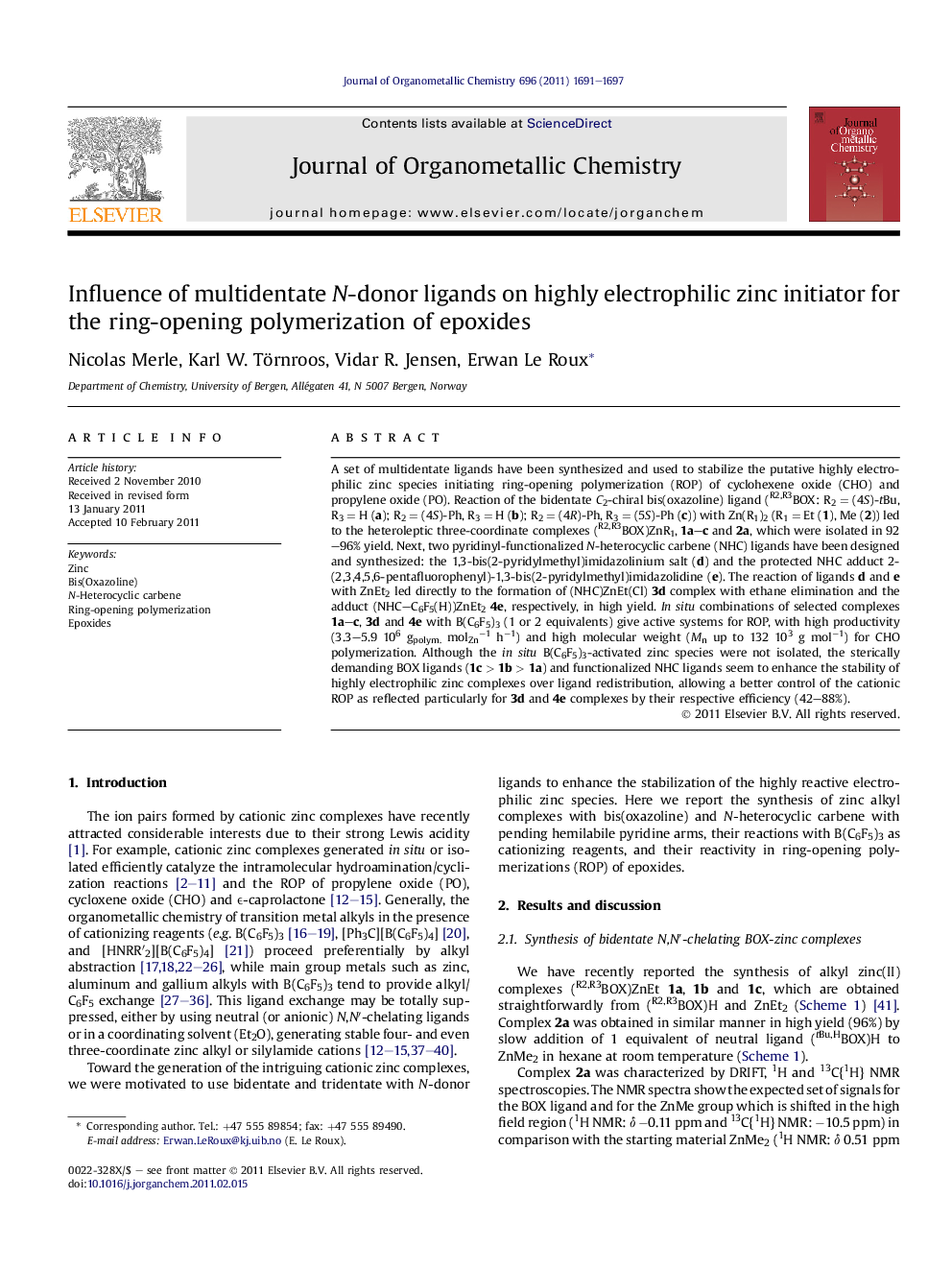| کد مقاله | کد نشریه | سال انتشار | مقاله انگلیسی | نسخه تمام متن |
|---|---|---|---|---|
| 1322360 | 977203 | 2011 | 7 صفحه PDF | دانلود رایگان |

A set of multidentate ligands have been synthesized and used to stabilize the putative highly electrophilic zinc species initiating ring-opening polymerization (ROP) of cyclohexene oxide (CHO) and propylene oxide (PO). Reaction of the bidentate C2-chiral bis(oxazoline) ligand (R2,R3BOX: R2 = (4S)-tBu, R3 = H (a); R2 = (4S)-Ph, R3 = H (b); R2 = (4R)-Ph, R3 = (5S)-Ph (c)) with Zn(R1)2 (R1 = Et (1), Me (2)) led to the heteroleptic three-coordinate complexes (R2,R3BOX)ZnR1, 1a–c and 2a, which were isolated in 92–96% yield. Next, two pyridinyl-functionalized N-heterocyclic carbene (NHC) ligands have been designed and synthesized: the 1,3-bis(2-pyridylmethyl)imidazolinium salt (d) and the protected NHC adduct 2-(2,3,4,5,6-pentafluorophenyl)-1,3-bis(2-pyridylmethyl)imidazolidine (e). The reaction of ligands d and e with ZnEt2 led directly to the formation of (NHC)ZnEt(Cl) 3d complex with ethane elimination and the adduct (NHC–C6F5(H))ZnEt24e, respectively, in high yield. In situ combinations of selected complexes 1a–c, 3d and 4e with B(C6F5)3 (1 or 2 equivalents) give active systems for ROP, with high productivity (3.3–5.9 106 gpolym. molZn−1 h−1) and high molecular weight (Mn up to 132 103 g mol−1) for CHO polymerization. Although the in situ B(C6F5)3-activated zinc species were not isolated, the sterically demanding BOX ligands (1c > 1b > 1a) and functionalized NHC ligands seem to enhance the stability of highly electrophilic zinc complexes over ligand redistribution, allowing a better control of the cationic ROP as reflected particularly for 3d and 4e complexes by their respective efficiency (42–88%).
A series of bis(oxazoline) and N-heterocyclic carbene (salt or protected) zinc alkyls have been synthesized. Such complexes when contacted with B(C6F5)3, generate uncharacterizable active initiators for the ring-opening polymerization of epoxides which show high activity (TOF up to 60 103 h−1) and high molecular weight (up to 175 103 g mol−1). The influence of N-donor ligands on putative highly electrophilic zinc species formed in situ during the cationic polymerization is also discussed.Figure optionsDownload as PowerPoint slideHighlights
► Synthesis of new pyridinyl-functionalized NHC ligands (salt and protected adducts).
► Synthesis of new heteroleptic BOX, NHC and unprotected NHC zinc alkyls complexes.
► B(C6F5)3-activated zinc complexes present high TOFs and Mw for the ROP of epoxides.
► Multidentate N-donor ligands stabilize better Zn species during cationic ROP.
► Functionalized NHCs allow better control over ligands redistribution during the ROP.
Journal: Journal of Organometallic Chemistry - Volume 696, Issue 8, 15 April 2011, Pages 1691–1697